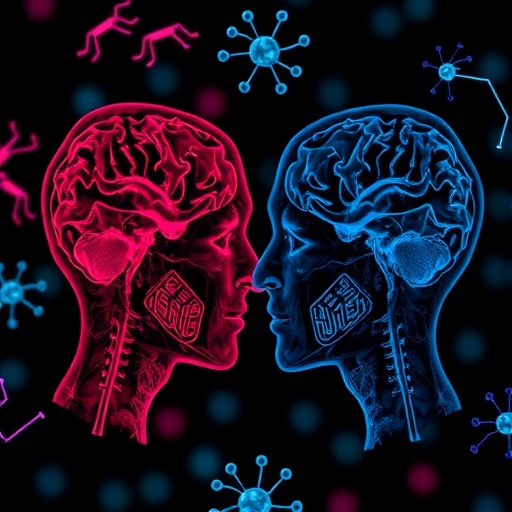In a groundbreaking study published in BMC Psychiatry, researchers have unearthed compelling biological distinctions between two complex psychiatric conditions: bipolar disorder at mixed episodes (BDM) and major depressive disorder with mixed features (MDM). These findings open new avenues for understanding the nuanced biochemical landscapes underlying these disorders, hinting at tailored diagnostic and treatment strategies grounded in peripheral blood biomarkers. While traditional psychiatric diagnoses have predominantly relied on symptomatic assessment, this research shifts focus to the profound physiological alterations accompanying mood disorders, particularly emphasizing immune-inflammatory and thyroid hormone parameters.
The retrospective investigation analyzed an extensive dataset involving 269 patients diagnosed with BDM and 86 individuals presenting MDM. These cohorts were scrutinized for a broad spectrum of biochemical indices encompassing immune-inflammatory markers, liver function metrics, metabolic profiles, and thyroid hormones. Leveraging sophisticated logistic regression models, the team delineated vital associations linking these biochemical signatures to their corresponding psychiatric diagnoses. Additionally, advanced network analysis and Principal Component Analysis (PCA) were employed, providing an intricate map of inter-parameter relationships that may elucidate the pathophysiological divergences between BDM and MDM.
Key revelations from the study underscore a distinct immunological and endocrine fingerprint in BDM patients relative to their MDM counterparts. Specifically, elevated neutrophil percentages and white blood cell counts were prominent in the BDM group, highlighting a state of heightened immune activation or systemic inflammation. Concurrently, free triiodothyronine (FT3) and free thyroxine (FT4)—the biologically active thyroid hormones—were significantly increased among those with BDM. These thyroid hormone elevations could reflect perturbations in neuroendocrine regulation that modulate mood and cognitive function, suggesting a mechanistic role in the mixed manic-depressive states characteristic of bipolar disorder.
In contrast, individuals with MDM exhibited amplified levels of C-reactive protein (CRP), a well-established marker of systemic inflammation, alongside increased direct bilirubin (DBIL) and prealbumin (PA). The rise in CRP points toward a pervasive inflammatory milieu associated more robustly with depressive symptoms entwined with mixed features, while shifts in bilirubin and prealbumin may imply subtle oxidative stress or altered liver metabolism. Intriguingly, unlike the positive associations seen with immune and thyroid parameters in BDM, PA and DBIL displayed negative correlations with BDM diagnosis, delineating a biochemical profile largely divergent from bipolar mixed episodes.
Despite these biochemical disparities, comparative network analyses revealed no significant differences in the overall network structures or global strengths when juxtaposing BDM and MDM groups. This suggests that while individual markers differ, the overarching interconnected biochemical frameworks may maintain shared pathological architectures. Such findings hint at a complex interplay of overlapping yet distinct biological processes, potentially offering a unified platform for future integrative models of mood disorder pathogenesis.
The implications of this research resonate deeply within clinical psychiatry, as peripheral biochemical markers could serve as accessible, non-invasive adjuncts to conventional diagnostic tools. By identifying immune-inflammatory and thyroid hormone markers that discriminate between BDM and MDM, clinicians might better tailor pharmacological and therapeutic interventions, improving outcomes through personalized medicine approaches. This study’s lens on peripheral inflammation and endocrine factors aligns with growing evidence situating mood disorders within a systemic physiological context rather than isolated neurochemical imbalances.
Methodologically, the rigor of this study is underscored by its sizable patient cohorts and the application of robust statistical techniques. Logistic regression provided quantifiable measures of association strength, while network and PCA analyses afforded dimensionality reduction and visualization of complex biochemical interrelations. Such multivariate approaches enhance the interpretability of the intricate biological data, reinforcing confidence in the distinct biomarker profiles characterizing these psychiatric phenotypes.
Furthermore, the study addresses an urgent gap in psychiatric biomarker research by focusing on mixed states, a notoriously challenging clinical presentation due to overlapping symptomatology. The differentiation of BDM and MDM at a molecular level could revolutionize the clinical delineation of mood disorders, enabling earlier and more accurate diagnoses. This is particularly critical as treatment responsiveness varies markedly between bipolar and unipolar depressive spectrums, with potential ramifications for medication selection and risk mitigation.
The emerging link between thyroid hormones and mood disorder subtypes is especially intriguing given thyroid axis involvement in neuroplasticity, neurotransmission, and immune modulation. Elevated FT3 and FT4 in BDM might reflect an adaptive or maladaptive thyroid response to neuropsychiatric stressors, warranting further mechanistic exploration. This could pave the way for adjunctive thyroid-targeted therapies or monitoring strategies within bipolar treatment protocols.
Similarly, the immune-inflammatory findings spotlight the dynamic role of systemic inflammation in psychiatric pathology. Elevated neutrophil counts and CRP levels underscore the potential utility of anti-inflammatory agents as therapeutic adjuncts. Investigations into how immunomodulatory treatments impact mood episode recurrence or severity in BDM and MDM populations could be a promising trajectory for future clinical trials.
While this study enriches the biochemical landscape of mixed mood states, it also raises imperative questions regarding causality versus consequence. Are these peripheral markers reflective of upstream neurobiological dysfunction driving the disorders, or are they epiphenomena arising secondary to systemic illness? Longitudinal and mechanistic studies will be vital to untangle these complexities and harness biomarker utility fully.
In conclusion, the identification of divergent peripheral biochemical patterns between bipolar disorder in mixed states and major depressive disorder with mixed features advances psychiatric research beyond symptom-based taxonomies. Integrating immune-inflammatory and thyroid hormone indices into diagnostic and therapeutic frameworks offers a tantalizing prospect for precision psychiatry. As mental health care continues to embrace biological stratification, studies like this one underscore the importance of multidimensional assessment, laying a foundation for more effective and individualized patient management in complex mood disorders.
Subject of Research: Comparison of peripheral biochemical parameters between bipolar disorder at mixed episodes (BDM) and major depressive disorder with mixed features (MDM).
Article Title: Bipolar disorder at mixed states and major depressive disorder with mixed features differ in peripheral biochemical parameters
Article References:
Wu, X., Wang, S., Niu, Z. et al. Bipolar disorder at mixed states and major depressive disorder with mixed features differ in peripheral biochemical parameters. BMC Psychiatry 25, 362 (2025). https://doi.org/10.1186/s12888-025-06800-9
Image Credits: Scienmag.com




